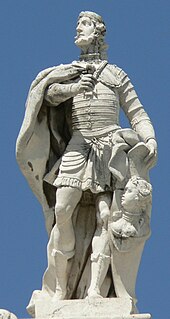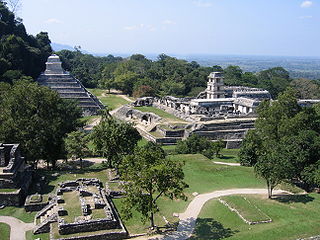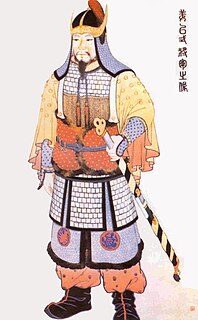Events
590
By place
Byzantine Empire
- Byzantine–Sassanid War: Emperor Maurice defeats the Persian forces under Bahrām Chobin at Nisibis (modern Turkey), and drives them back into Armenia.
- Comentiolus, commander ( magister militum ) of the eastern army, receives the legitimate Persian king, Khosrau II, as a refugee in his headquarters at Hierapolis.
- Maurice establishes the Exarchate of Carthage in Africa. He combines the civil authority of a praetorian prefect and the military authority, based at Carthage.
- March 26 – Theodosius, eldest son of Maurice, is proclaimed as co-emperor. He becomes his father's heir to the Byzantine throne. [1]
- Stephen I succeeds his father Guaram I as king of Iberia (Georgia) (approximate date).

Maurice was Byzantine Emperor from 582 to 602. A prominent general, Maurice fought with success against the Sasanian Empire. After he became Emperor, he brought the war with Sasanian Persia to a victorious conclusion. Under him the Empire's eastern border in the South Caucasus was vastly expanded and, for the first time in nearly two centuries, the Romans were no longer obliged to pay the Persians thousands of pounds of gold annually for peace.
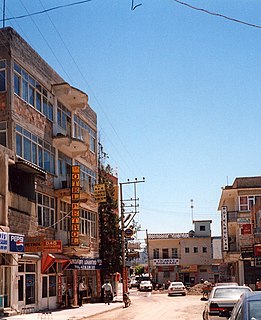
Nusaybin is a city in Mardin Province, Turkey. The population of the city is 83,832 as of 2009. The population is predominantly Kurdish, Sunni as well as Yezidi, but a small Assyrian community can also be found.

Turkey, officially the Republic of Turkey, is a transcontinental country located mainly on the Anatolian peninsula in Western Asia, with a small portion on the Balkan peninsula in Southeast Europe. East Thrace, the part of Turkey in Europe, is separated from Anatolia by the Sea of Marmara, the Bosphorous and the Dardanelles. Turkey is bordered by Greece and Bulgaria to its northwest; Georgia to its northeast; Armenia, the Azerbaijani exclave of Nakhchivan and Iran to the east; and Iraq and Syria to the south. Istanbul is the largest city while Ankara is the capital. Approximately 70 to 80 per cent of the country's citizens identify as Turkish. Kurds are the largest minority; the size of the Kurdish population is a subject of dispute with estimates placing the figure at anywhere from 12 to 25 percent of the population.
Europe
- The Franks and Burgundians under King Guntram invade Italy. They capture the cities Milan and Verona, but are forced to leave by a plague outbreak in the Po Valley.
- The Franks again invade Italy; they capture Modena and Mantua. Several Lombard dukes defect: Gisulf I, duke of Friuli, is defeated and replaced by his son Gisulf II.
- September 5 – King Authari dies (possibly by poison) after a 6-year reign, and is succeeded by Agilulf, duke ( dux ) of Turin, who marries his widow Theodelinda.
- Frankish rebellion lead by Basina, daughter of Chilperic I.

The Franks were a group of Germanic peoples, whose name was first mentioned in 3rd century Roman sources, associated with tribes on the Lower and Middle Rhine, on the edge of the Roman Empire. Later the term was associated with Romanized Germanic dynasties within the collapsing Western Roman Empire, who eventually commanded the whole region between the rivers Loire and Rhine. They then imposed power over many other post-Roman kingdoms and Germanic peoples, and still later Frankish rulers were given recognition by the Catholic Church as successors to the old rulers of the Western Roman Empire.

The Burgundians were a large East Germanic tribe or group of tribes that lived in the time of the Roman Empire in the region of Germania that is now part of Poland.
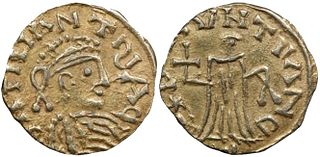
Saint Gontrand, also called Gontran, Gontram, Guntram, Gunthram, Gunthchramn, and Guntramnus, was the king of the Kingdom of Orleans from AD 561 to AD 592. He was the third eldest and second eldest surviving son of Chlothar I and Ingunda. On his father's death in 561, he became king of a fourth of the Kingdom of the Franks, and made his capital at Orléans. The name "Gontrand" denotes " War Raven".
Britain
- Æthelberht succeeds his father Eormenric as king ( bretwalda ) of Kent (according to the Anglo-Saxon Chronicle ).
- Siege of Lindisfarne: A Brythonic coalition lays siege to King Hussa of Bernicia at Lindisfarne Castle (Holy Island).
- Owain mab Urien succeeds his father Urien, as Brythonic king of Rheged in Northern England (approximate date).
Æthelberht was King of Kent from about 589 until his death. The eighth-century monk Bede, in his Ecclesiastical History of the English People, lists him as the third king to hold imperium over other Anglo-Saxon kingdoms. In the late ninth century Anglo-Saxon Chronicle, he is referred to as a bretwalda, or "Britain-ruler". He was the first English king to convert to Christianity.
Eormenric of Kent was King of Kent from c. 534/540 to 564/580. His father may have been Octa of Kent, whom Eormenric succeeded. His son, Æthelberht of Kent, in turn succeeded him around 580/590, according to the Anglo-Saxon Chronicle.

Bretwalda is an Old English word. The first record comes from the late 9th-century Anglo-Saxon Chronicle. It is given to some of the rulers of Anglo-Saxon kingdoms from the 5th century onwards who had achieved overlordship of some or all of the other Anglo-Saxon kingdoms. It is unclear whether the word dates back to the 5th century and was used by the kings themselves or whether it is a later, 9th-century, invention. The term bretwalda also appears in a 10th-century charter of Æthelstan. The literal meaning of the word is disputed and may translate to either 'wide-ruler' or 'Britain-ruler'.
Persia
- Spring – King Hormizd IV dismisses Bahrām Chobin as commander ( Eran spahbed ). He revolts and marches with the support of the Persian army towards Ctesiphon.
- February 15 – Hormizd IV is deposed and assassinated by Persian nobles. Having ruled since 579, he is succeeded by his son Khosrau II as king of the Persian Empire.
- September – Bahrām Chobin defeats the inferior forces of Khosrau II near Ctesiphon. He seizes the throne and proclaims himself as king Bahrām IV of Persia.

Hormizd IV was Sasanian King of Kings of Iran from 579 to 590. He was the son and successor of Khosrow I and his mother was a Khazar princess.

Spāhbed is a Middle Persian title meaning "army chief" used chiefly in the Sasanian Empire. Originally there was a single spāhbed, called the Ērān-spāhbed, who functioned as the generalissimo of the Sasanian army. From the time of Khosrow I on, the office was split in four, with a spāhbed for each of the cardinal directions. After the Muslim conquest of Persia, the spāhbed of the East managed to retain his authority over the inaccessible mountainous region of Tabaristan on the southern shore of the Caspian Sea, where the title, often in its Islamic form ispahbadh, survived as a regnal title until the Mongol conquests of the 13th century. An equivalent title of Persian origin, ispahsālār, gained great currency across the Muslim world in the 10th–15th centuries.

Ctesiphon was an ancient city, located on the eastern bank of the Tigris, and about 35 kilometres (22 mi) southeast of present-day Baghdad. Ctesiphon served as a royal capital of the Persian Empire in the Parthian and Sasanian eras for over eight hundred years. Ctesiphon remained the capital of the Sasanian Empire until the Muslim conquest of Persia in 651 AD.
Asia
- Kadungon becomes king of the Pandyan Kingdom in South India (approximate date).
- Yeongyang becomes ruler of the Korean kingdom of Goguryeo. [2]
Kadungon was a Pandya king who revived the Pandya rule in South India in the 6th century CE. Along with the Pallava king Simhavishnu, he is credited with ending the Kalabhra rule, marking the beginning of a new era in the Tamil speaking region. Most historians, including R. C. Majumdar, state the period of Kadungon rule as 590–620 CE.

South India is the area including the five southern Indian states of Andhra Pradesh, Karnataka, Kerala, Tamil Nadu and Telangana, as well as the three union territories of Andaman and Nicobar islands, Lakshadweep and Puducherry, occupying 19% of India's area. Covering the southern part of the peninsular Deccan Plateau, South India is bounded by the Bay of Bengal in the east, the Arabian Sea in the west and the Indian Ocean in the south. The geography of the region is diverse with two mountain ranges–the Western and Eastern Ghats, bordering the plateau heartland. Godavari, Krishna, Kaveri, Tungabhadra, Periyar and Vaigai Palar rivers are important non-perennial sources of water. Bengaluru, Chennai, Hyderabad, Coimbatore, Kochi, Trivandrum, Visakhapatnam,Vellore, Tiruchirapalli, Madurai, Mysuru, Mangalore and Kozhikode are the largest urban areas.
Yeongyang of Goguryeo was the 26th monarch of Goguryeo, the northernmost of the Three Kingdoms of Korea. He was the eldest son of Pyeongwon of Goguryeo.
By topic
Religion
- February 7 – Pope Pelagius II falls victim to the plague that devastated Rome. After an 11-year reign he is succeeded by Gregory I, age 50, as the 64th pope, and the first from a monastic background.
- Egidius, bishop of Reims, is tried at Metz before a council of bishops for a conspiracy against King Childebert II; he is found guilty and exiled to Strasbourg.
- Gregory I begins a vigorous program of rebuilding aqueducts and restoring Rome. He feeds the citizens with doles of grain, as under Roman imperial rule.
- Columbanus, Irish missionary, obtains from King Guntram the Gallo-Roman castle Luxovium (Luxeuil-les-Bains), where he founds the Abbey of Luxeuil. [3]
- John of Biclaro, Visigoth chronicler, finishes his "Chronicle" before he is appointed bishop of Girona (Catalonia, Spain).
February 7 is the 38th day of the year in the Gregorian calendar. 327 days remain until the end of the year.

Pope Pelagius II was Pope from 26 November 579 to his death in 590.

Rome is the capital city and a special comune of Italy. Rome also serves as the capital of the Lazio region. With 2,872,800 residents in 1,285 km2 (496.1 sq mi), it is also the country's most populated comune. It is the fourth most populous city in the European Union by population within city limits. It is the centre of the Metropolitan City of Rome, which has a population of 4,355,725 residents, thus making it the most populous metropolitan city in Italy. Rome is located in the central-western portion of the Italian Peninsula, within Lazio (Latium), along the shores of the Tiber. The Vatican City is an independent country inside the city boundaries of Rome, the only existing example of a country within a city: for this reason Rome has been often defined as capital of two states.
== {{dr|y|y|{{{year}}}0|{{{1}}}|n{{#ifexpr:{{{year}}}<10|a}}}} == {{trim|{{transcluded-section|{{dr|y|y|{{{year}}}0|{{{1}}}|n{{#ifexpr:{{{year}}}<100|a}}}}}} {{#section-h::{{dr|y|y|{{{year}}}0|{{{1}}}|n{{#ifexpr:{{{year}}}<100|a}}}}|Events}}}} == {{dr|y|y|{{{year}}}0|{{{1}}}|n{{#ifexpr:{{{year}}}<10|a}}}} == {{trim|{{transcluded-section|{{dr|y|y|{{{year}}}0|{{{1}}}|n{{#ifexpr:{{{year}}}<100|a}}}}}} {{#section-h::{{dr|y|y|{{{year}}}0|{{{1}}}|n{{#ifexpr:{{{year}}}<100|a}}}}|Events}}}} == {{dr|y|y|{{{year}}}0|{{{1}}}|n{{#ifexpr:{{{year}}}<10|a}}}} == {{trim|{{transcluded-section|{{dr|y|y|{{{year}}}0|{{{1}}}|n{{#ifexpr:{{{year}}}<100|a}}}}}} {{#section-h::{{dr|y|y|{{{year}}}0|{{{1}}}|n{{#ifexpr:{{{year}}}<100|a}}}}|Events}}}} == {{dr|y|y|{{{year}}}0|{{{1}}}|n{{#ifexpr:{{{year}}}<10|a}}}} == {{trim|{{transcluded-section|{{dr|y|y|{{{year}}}0|{{{1}}}|n{{#ifexpr:{{{year}}}<100|a}}}}}} {{#section-h::{{dr|y|y|{{{year}}}0|{{{1}}}|n{{#ifexpr:{{{year}}}<100|a}}}}|Events}}}} == {{dr|y|y|{{{year}}}0|{{{1}}}|n{{#ifexpr:{{{year}}}<10|a}}}} == {{trim|{{transcluded-section|{{dr|y|y|{{{year}}}0|{{{1}}}|n{{#ifexpr:{{{year}}}<100|a}}}}}} {{#section-h::{{dr|y|y|{{{year}}}0|{{{1}}}|n{{#ifexpr:{{{year}}}<100|a}}}}|Events}}}} == {{dr|y|y|{{{year}}}0|{{{1}}}|n{{#ifexpr:{{{year}}}<10|a}}}} == {{trim|{{transcluded-section|{{dr|y|y|{{{year}}}0|{{{1}}}|n{{#ifexpr:{{{year}}}<100|a}}}}}} {{#section-h::{{dr|y|y|{{{year}}}0|{{{1}}}|n{{#ifexpr:{{{year}}}<100|a}}}}|Events}}}} == {{dr|y|y|{{{year}}}0|{{{1}}}|n{{#ifexpr:{{{year}}}<10|a}}}} == {{trim|{{transcluded-section|{{dr|y|y|{{{year}}}0|{{{1}}}|n{{#ifexpr:{{{year}}}<100|a}}}}}} {{#section-h::{{dr|y|y|{{{year}}}0|{{{1}}}|n{{#ifexpr:{{{year}}}<100|a}}}}|Events}}}} == {{dr|y|y|{{{year}}}0|{{{1}}}|n{{#ifexpr:{{{year}}}<10|a}}}} == {{trim|{{transcluded-section|{{dr|y|y|{{{year}}}0|{{{1}}}|n{{#ifexpr:{{{year}}}<100|a}}}}}} {{#section-h::{{dr|y|y|{{{year}}}0|{{{1}}}|n{{#ifexpr:{{{year}}}<100|a}}}}|Events}}}} == {{dr|y|y|{{{year}}}0|{{{1}}}|n{{#ifexpr:{{{year}}}<10|a}}}} == {{trim|{{transcluded-section|{{dr|y|y|{{{year}}}0|{{{1}}}|n{{#ifexpr:{{{year}}}<100|a}}}}}} {{#section-h::{{dr|y|y|{{{year}}}0|{{{1}}}|n{{#ifexpr:{{{year}}}<100|a}}}}|Events}}}}



